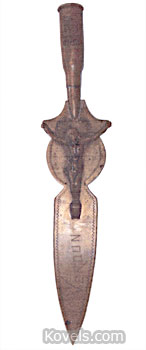Q: I have what I think might be a brass letter opener. It’s about 8 inches long. It was given to me by my father, who fought in Verdun, France, during World War I. The word “Verdun” is engraved on the blade. Can you tell me more about it?
A: Your letter opener is a piece of trench art, a form of folk art made by soldiers. Metal casings from bullets and mortar shells were cut and decorated to form ashtrays, lighters, letter openers, vases, and other useful items. The Battle of Verdun, fought in 1916, lasted 300 days and was the longest battle of World War I. That was before the United States declared war on Germany on April 6, 1917. Americans fought in the Verdun area from Sept. 17, 1918, until the war ended on Nov. 11 of that year. Many trench art items were made from the refuse of the Battle of Verdun and later battles fought in the same region. Some items were made by soldiers when they were not actively involved in the fight, some by soldiers who were recuperating from injuries, some by prisoners of war, and some after the battle by civilians who sold them as souvenirs to soldiers or tourists. Trench art is a folk art form that is not yet collected by many, so values are low. Letter openers sell for $20-$60. Vases are the most desirable and can bring several hundred dollars.




Leave a Reply
You must be logged in to post a comment.